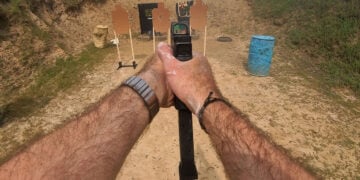In December of 2022, we wrote about the 10-Round Assault Course. Originally designed as a pistol drill, I have adapted it to my favorite firearm, the shotgun. While the pistol version of the 10-Round Assault Course is pretty straightforward, things get interesting with the shotgun as we cover a much larger set of skills.
Scoring Adjustments
Obviously, we have to make some changes in how this drill works to get it to fit inside a shotgun-sized box. Most notably, the scoring. B-8 repair centers and shotguns loaded with buckshot don’t exactly go together that well. Instead of scoring points and time, we are just going to score time and assess a time penalty for hits outside of our scoring zone. Each pellet striking outside of the primary zone will add 1 second to the raw time. Each slug will add 10 seconds.
Speaking of the scoring zone, we need to figure out what that is. Personally, I think an 8” circle is about right for this one. It is an anatomically significant target size and just on the edge of what generic buckshot can do at 15-ish yards out of an equally generic shotgun. There are plenty of printable targets out there with 8” circles, so it makes for a readily accessible target size too. A standard piece of printer paper wouldn’t be horrible either, but it is getting to the upper limit of what I think is useful.
The 25-Yard Line
This is how this will work. Load the shotgun with six rounds of buckshot, and have two slugs either in a side saddle or somewhere easy to get to, like a pocket. Start from a low ready at 25 yards. On the start signal, perform a double slug changeover (see video below.) Now here is the catch, you have to perform the double slug changeover as if the gun is fully loaded, even though it may not actually be. It is an artificiality, but it is necessary to make the round count work for the drill. Two shells need to come out of the gun, and two shells need to go into the gun.
Fire the two slugs standing unsupported from 25 yards.
The 15-Yard Line
Quickly move to the 15-yard line and fire two rounds of buckshot. This is where knowing your buckshot really matters, and knowing how strict you need to be on pressing these two shots while keeping all of the pellets in the target zone. If you are running good buckshot or have an exceptionally good patterning shotgun, this should be easy to shoot. If you are trying to make this work with lower-tier loads, there will probably be a price to be paid with pellets outside of the primary scoring zone.
The 7-Yard Line
Aggressively move to the 7-yard line and fire two more rounds of buckshot. After those two rounds, the shotgun should be empty, but we are only six rounds into a 10-round drill.
Transition to your pistol and fire one round stationery, then fire three rounds on the move forward of the 7-yard line. That ends the course of fire.
Record your time after the last shot is fired, and then check the target to see if any penalties need to be added. Your raw time, plus penalties, is the score for the drill.
The Wrap
There is a lot on the table here. A double slug changeover, aggressive movement forward, transition to the pistol at an appropriate distance, and shooting on the move with the pistol. I would recommend being careful about stepping into this one without some training on how to do it all. If you are comfortable with the skills and have a range that will allow this type of drill, it is a fun one, but it could be a bit daunting for the less experienced.
If you give it a try, drop your time in the comments.









